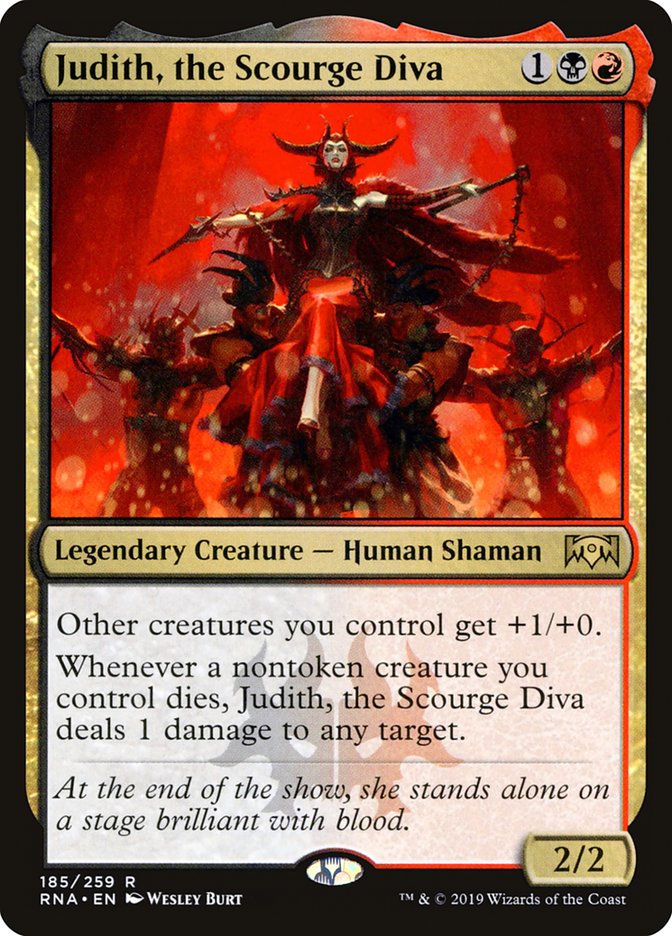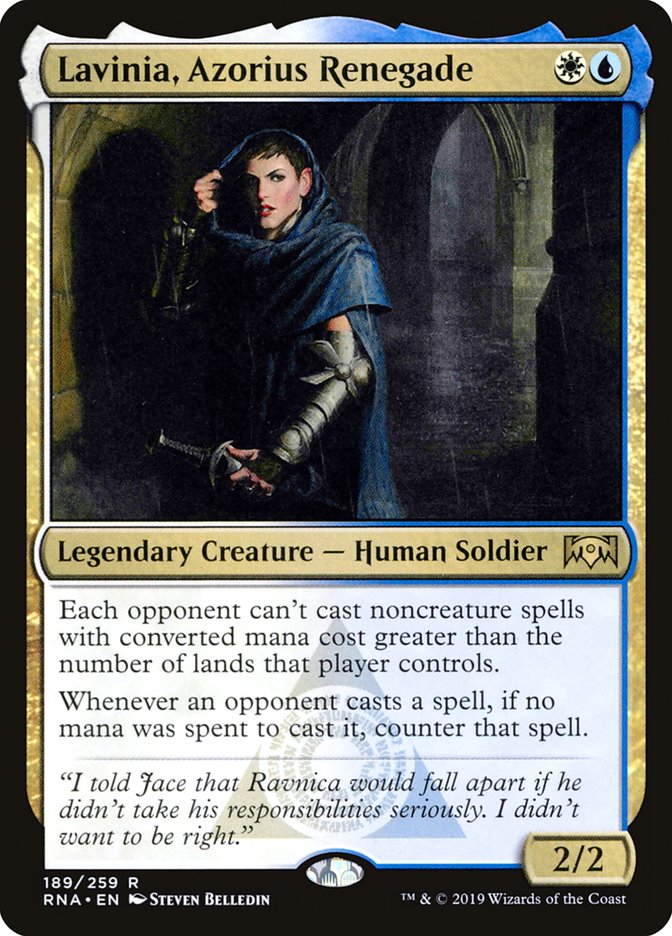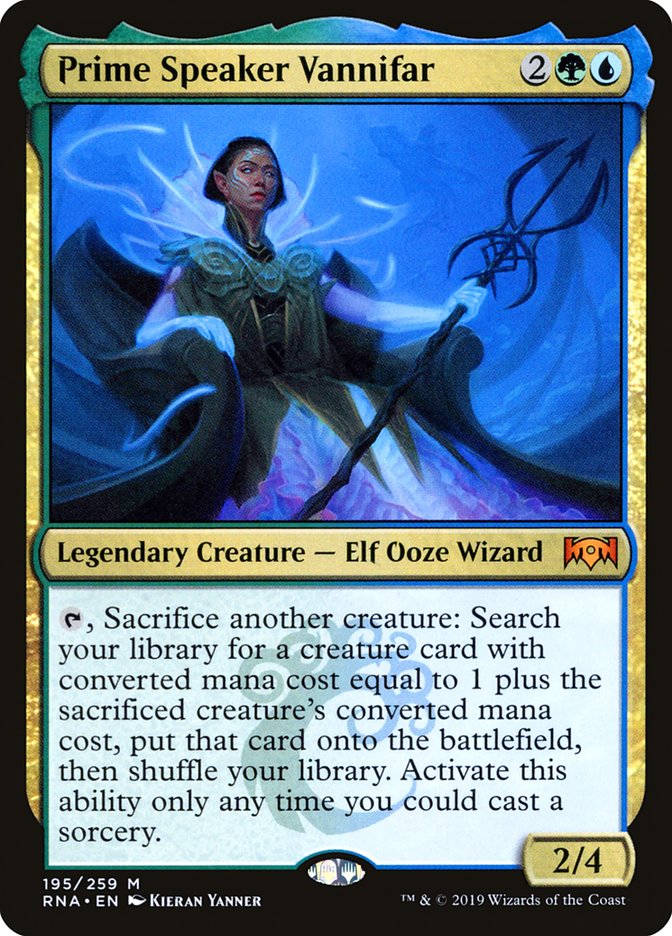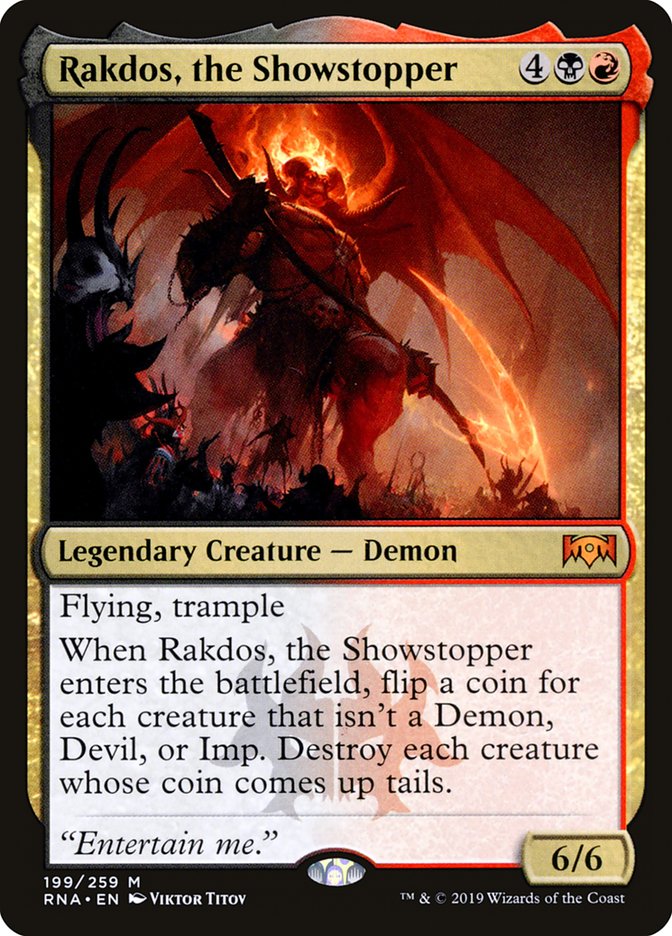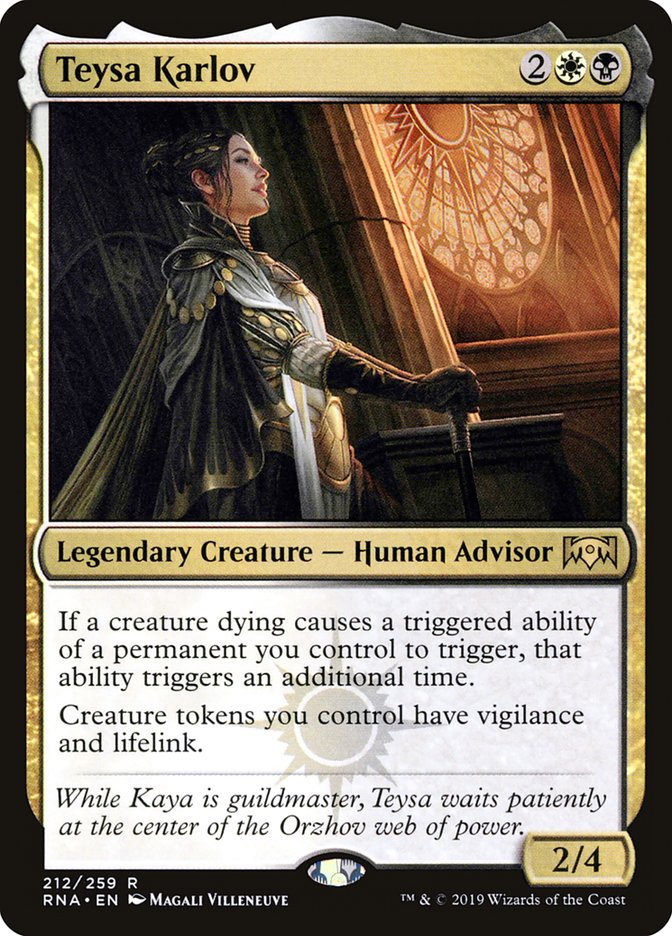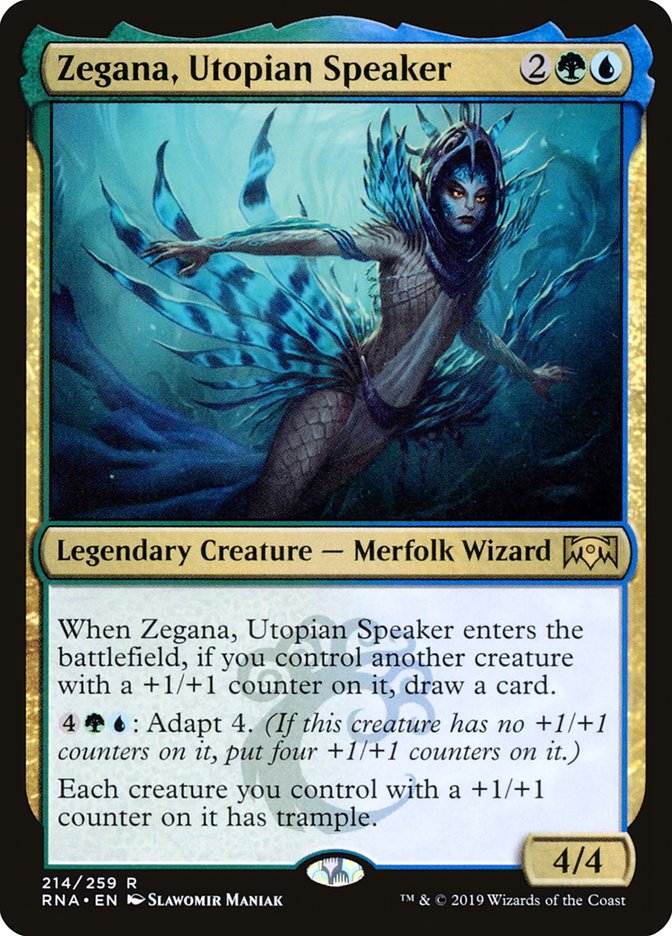As of the moment I’m writing this sentence, we’ve seen six legendary
creatures from Ravnica Allegiance. They’re not balanced across the
guilds, with two Simic, two Rakdos, one Azorius, and one Orzhov (the only
true guild), but that’s not going to stop us from taking a look at the
kinds of decks we might consider building from them. The list of officially
previewed cards is still small, but we can get a picture of the types of
cards and mechanics that might be present. We can combine that with
existing cards and start crafting ideas.
The first Rakdos offering reinforces the guild’s message that life is
short. Judith’s first ability, to give your creatures +1/+0, leads us
toward a token or swarm strategy. The more creatures you have, the more
damage Judith will help you deal. That’s only the beginning.
The second ability, to deal damage to any target when a nontoken creature
you control dies, limits the benefit of the token strategy. In its stead,
it guides us toward a strategy of creature recursion. Cards like Oversold
Cemetery and Palace Siege can put cards back into our hands to cast
again-leading to the thought that less-expensive creatures utility
creatures might be the way to go. A favorite of mine is Bone Shredder,
which is kind enough to have an echo cost that we can ignore and get it
into the graveyard. It also has flying, so it’s an excellent chump blocker.
We can instead go with cards that put creatures from the graveyard back
onto the battlefield, like Dawn of the Dead or Corpse Dance. Just be
careful to have a sacrifice outlet for both of them, since the creature
will otherwise get exiled later on. Nobody wants that.
That Judith’s triggered ability deals damage (as opposed to causing life
loss) is significant. If you want to start killing off creatures, just find
something that gives her (or all your creatures) deathtouch. Basilisk
Collar is both effective and inexpensive plus it gives the
equipped creature lifelink. Archetype of Finality is more expensive, but it
gives deathtouch to all your creatures and makes it so that opponents’
creatures can’t have it. Otherwise, your choices are limited; Judith is a
Human Shaman, so you can’t use the barely-playable Fellhide Petrifier, and
Maze Abomination only applies to multicolored creatures-but perhaps that
might be more valuable in this set. Baleful Eidolon is the only other
reasonable choice in Rakdos colors.
On the adaptability scale, Judith gets a moderate rating. She’s not limited
to a single path, but not broadly open either. I might be inclined to use
her as 1 of 99 instead of as a commander.
I’m generally not a fan in Commander of cards that say “each opponent
can’t.” As we’ve recently discussed, the game is better when everyone gets
a chance to play instead of watch. That’s the end of what I might dislike
about this Lavinia version, because the rest of it might be the salve that
heals a few of the format’s wounds. It will shut down non-land acceleration
strategies, like with Elves or anything with a bunch of mana rocks getting
into Tooth and Nail. It will make an early Blasphemous Act not viable, and
so on. The second ability in particular has impact in this (and likely
other) format(s), especially Eternal ones, countering spells that have the
“may cast without paying its mana cost” clause. While there are 96 cards in
Magic that have the clause, the ones relevant to Commander are Aetherworks
Marvel; Baral’s Expertise; Diluvian Primordial; Djinn of Wishes; Eye of the
Storm; Intet, the Dreamer; Isochron Scepter; Jeleva, Nephalia’s Scourge;
(personal favorite) Kheru Spellsnatcher; Knowledge Exploitation, Memory
Plunder; Mind’s Dilation (one of the biggies); Mosswort Bridge; Possibility
Storm; Rashmi, Eternities Crafter; Rishkar’s Expertise; Sunforger;
Unexpected Results; and, of course, Omniscience.
The downside to this version of Lavinia is that Azorius depends on mana
rocks to stay in games which develop early. Getting some kind of ramp, like
Wayfarer’s Bauble, into your blue/white decks might become even more
critical if you’re playing her. At the very least, upping the land count to
about 40 in a Lavinia, Azorius Renegade deck will ensure that you hit all
your early land drops most of the time.
I’d rate Lavinia’s flexibility in the medium to good range. It doesn’t
necessarily lead you down a path, it only tells you a few directions that
you can’t do. I might consider having her lead my Lavinia Blinks deck just
to see how it would go.
Okay, I’m going to get it out of the way early. I’ve lately been playing
lots of Witcher 3. It was one of the games that helped get me
through recovery from radiation two years ago and through surgery this
time. There’s an important character named Yennefer, and this Prime Speaker
will always be her in my mind.
As to the card itself, holy Birthing Pod on a stick! Whether it’s leading
the deck or is 1 of the 99, Vannifar is going to speak primely in
Commander. People will certainly be rushing out to build versions of the
deck that get into a nice progression like Yavimaya Elder into Solemn
Simulacrum into Seedborn Muse and so forth. My personal favorite stop at
six is Duplicant (Dupli-can, amirite?). Most folks will go from
there to Protean Hulk, but at least a Vannifar deck doesn’t have white for
the most broken P-Hulk shenanigans.
It occurs to me that I was thinking only of green and colorless as I went
into that Vannifar chain, but there have to be viable things in blue.
There’s an obvious path to having creatures with strong
enters-the-battlefield triggers, so Deadeye Navigator in the six hole seems
like a strong, if well-weathered, course. Aura Thief has to be one of my
favorites at four, although at some point you might not get maximum value
either out of the Thief or your chain. There’s certainly a path from two
(Phantasmal Image) to at least seven (Quicksilver Gargantuan) in the Clone
family. Since we’re in Simic, Progenitor Mimic is available as the only
choice at six with color, but that’s really not one you want to sacrifice.
As good as Prime Speaker Vannifar is, it’s definitely narrow. While you
might have a broad swath of creatures to choose from based on your tastes,
it does only a single thing. A single, wonderful thing.
This is the most playable of all the Rakdos versions. The original (Rakdos
the Defiler) is, well, just awkward. Rakdos, Lord of Riots can be extremely
strong, but it has a limiting condition. If you’re building around the new
one, you’re set up pretty good. It might even give you cause to play fun
old cards like Nettling Imp or Norritt. It might lead you to some
graveyard-swapping featuring Flayer of the Hatebound. Charmbreaker Devils
is nice for casting stuff for free (but watch out for the new Lavinia!).
Of course, where Rakdos, the Showstopper will be strongest is in a Demon
deck. Demons have come a long way since Lord of the Pit. I prefer Demons
that hurt you if you don’t make them happy, not these new ones like
Archfiend of Depravity, Harvester of Souls (okay, hardly new), Krav, the
Unredeemed, Razaketh, the Foulblooded, or Reaper from the Abyss. Okay,
maybe prefer is too strong of a word, but you get my point. Demons are too
good and too easy now.
Unfortunately, that’s really the path you have to go with this Rakdos. I
suppose you could run something that doesn’t care if all or some of your
creatures get killed, hitting people with triggers like from Blood Artist,
Falkenrath Noble, or the aforementioned Judith, Scourge Diva (who is a
Human Shaman and
Ari Lax has called “the best Blood Artist of All Time
“). In fact, early inclusion of both onto the preview list might give us a
peak into how the rest of the Rakdos cards in the set shape up. I imagine
the “life is short” message will continue.
Oh my Grave Pact! Oh my Blood Artist! You get the picture. Abilities
triggering when creatures die is already a thing in Commander. Teysa Karlov
doubles the fun. She certainly works in that regard as the commander or as
1 of 99. She slots right into decks with Karador, Ghost Chieftain, because
you know you want your creatures dying anyway. She also did quite well with
her namesakes, Teysa, Envoy of Ghosts and Teysa, Orzhov Scion.
Her second ability becomes a little more compelling when we consider that
there are plenty of cards in the color identity (or which have Orzhov
within it, like with Mardu) which create tokens. Edgar Markov is a more
recent one. Elenda, the Dusk Rose creates tokens and pairs quite nicely
with new Teysa’s ability. Kalitas, Traitor of Ghet makes quite some Zombie
tokens. It would be just too good to not play Tombstone Stairwell in a deck
led by Teysa. Tokens from the various Elspeths and Sorins certainly apply.
Then there’s the haymaker of all token spells, Storm Herd. Vigilance is
nice and all, but lifelink wins Commander games.
Teysa Karlov is the most flexible of the six cards we’re looking at today.
The primary limitation is that she has to command a creature deck which has
a strong token component to it, but after that, you’re limited only by your
creativity.
The new version of Zegana will slowly lure you to sleep until you hit the
last ability, and then your eyes pop open wide. She moves from good value
to savage. +1/+1 counters have lots of legs in Commander, so Zegana is
going to slot into quite a few decks, and the trample part is going to make
lots of folks dead quicker (as does Crowned Ceratok). If you have a Prime
Speaker Zegana deck, this cousin is going to be more than welcome at family
gatherings. Don’t even get me started when Vigor is involved.
Whether she’s leading the deck or just part of the ensemble, Zegana will be
giving trample to favorite creatures like Altered Ego, Forgotten Ancient,
Spike Weaver, and all those Plants created by Avenger of Zendikar (after
some landfall action). My initial thoughts were for a Hydra tribal deck.
We’re in the best ramp color (Ulvenwald Hydra hitting two angles for us),
so getting our X values high isn’t that difficult. I also though of cards
with monstrosity, like Arbor Colossus, Nemesis of Mortals, Polukranos,
World Eater, and Shipbreaker Kraken.
The fact that Zegana’s greater value is tied to +1/+1 counters is only just
barely a limitation. There are so many creatures with counters on them plus
so many other ways to put counters on them that you won’t have any trouble
finding the build that suits you best.
This first look at some of the new commanders available to us in Ravnica Allegiance is a nice peek into what might be coming in the
rest of the set. That peek shows us that there will be quite some cards for
Commander coming our way, and soon.
Question of the Week
This week’s question comes from Chris Shipper, who I mentioned
in last week’s piece
. Chris asks:
”
While cards like the recently previewed Prime Speaker Vannifar and
Razaketh, the Foulblooded are good in Commander, are they necessarily
good for the format given that repeatable tutoring throws the
singleton/higher variance feature of the format out the window?”
Chris’ question brings up something we obliquely talked about last week.
“Good in Commander” and “good for Commander” can be two different things.
Cards that limit other players’ ability to do anything have the greatest
delta between good in and good for, but Chris’ point is
well-taken. I think the format would stand a good chance of being better
with a permanent Stranglehold for everyone (but don’t panic; there’s no
plans to move it that way). Blanket tutors like Razaketh and Demonic Tutor
carry the biggest negatives, since they mostly lead down the same paths
(not always; some folks love to tutor for answers, not combo pieces).
Obviously, there’s no reasonable decision that gets rid of all of them (or
even some) and it’d cause quite a revolt if we tried. We’ll continue along
the road of sharing our vision that folks think about both the good in and good for sides of the equation.
Check out our comprehensive Deck List Database for lists of all my decks:
SIGNATURE DECKS
Purple Hippos and Maro Sorcerers
;
Kresh Into the Red Zone
;
Halloween with Karador
;
Dreaming of Intet
;
You Did This to Yourself
.
THE CHROMATIC PROJECT
Mono-Color
Heliod, God of Enchantments
;
Thassa, God of Merfolk
;
Erebos and the Halls Of The Dead
;
Forge of Purphoros
;
Nylea of the Woodland Realm
;
Karn
Evil No. 9.
Guilds
Lavinia Blinks
;
Obzedat, Ghost Killer
;
Aurelia Goes to War
;
Trostani and Her Angels
;
Lazav, Shapeshifting Mastermind
;
Zegana and a Dice Bag
;
Rakdos Reimagined
;
Glissa, Glissa
;
Ruric Thar and His Beastly Fight Club
;
Gisa and Geralf Together Forever
.
Shards and Wedges
Adun’s Toolbox
;
Angry, Angry Dinos
;
Animar’s Swarm
;
Borrowing Stuff at Cutlass Point
;
Ikra and Kydele
;
Karrthus, Who Rains Fire From The Sky
;
Demons of Kaalia
;
Merieke’s Esper Dragons
;
Nath of the Value Leaf
;
Queen Marchesa, Long May She Reign
;
Queen Marchesa’s Knights
;
Rith’s Tokens
;
The Mill-Meoplasm
;
The Altar of Thraximundar
;
The Threat of Yasova
;
Zombies of Tresserhorn
.
Four Color
Yidris: Money for Nothing, Cards for Free
;
Saskia Unyielding
;
Breya Reshaped
;
Yidris Rotisserie Draft Deck
.
Five-Color
Partners
Tana and Kydele
;
Kynaios and Tiro
;
Ikra and Kydele
.
THE DO-OVER PROJECT
Adun Oakenshield Do-Over
;
Animar Do-Over
;
Glissa Do-Over
;
Karador Do-Over
;
Karador Version 3
;
Karrthus Do-Over
;
Kresh Do-Over
;
Steam-Powered Merieke
Do-Over;
Lord of Tresserhorn Do-Over
;
Mimeoplasm Do-Over
;
Phelddagrif Do-Over
;
Rith Do-Over
;
Ruhan Do-Over
.
If you’d like to follow the adventures of my Monday Night RPG group (in a
campaign that’s been alive since 1987) which is just beginning the saga The Lost Cities of Nevinor, ask for an invitation to the Facebook
group “Sheldon Menery’s
Monday Night Gamers.”


